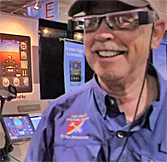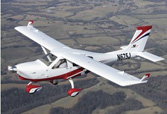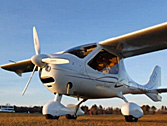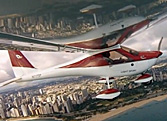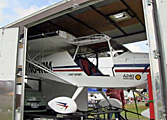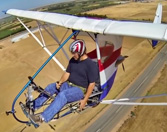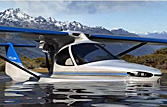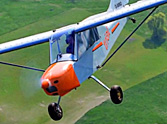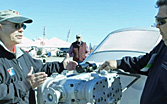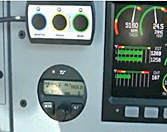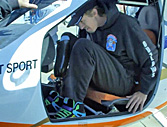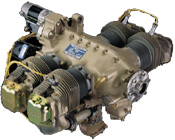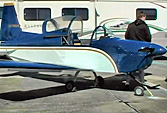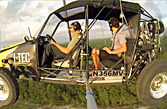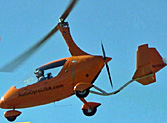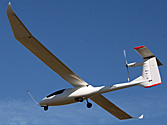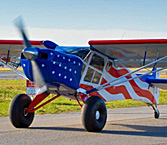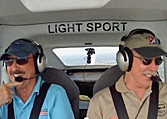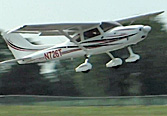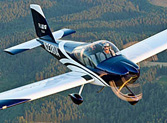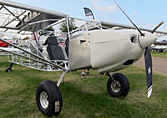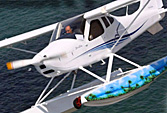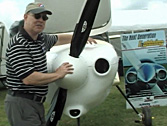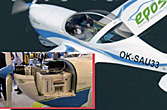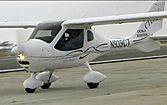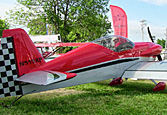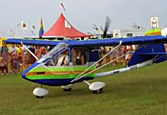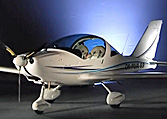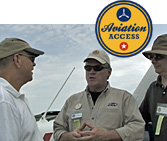Our video with Levil’s Joe Marszal starts out with something absolutely new at AirVenture 2014. You can see Dan Johnson modeling and using AeroGlass, which might be called “Google Glass for pilots.” The developer had a blow-out event and Levil, makers of GPS and AHRS systems for iPad and Android tablets, partnered up with the AeroGlass folks to power a fascinating heads-up display that can be used in a Light-Sport or homebuilt aircraft. Some great info is contained on this video.
When people visit the Midwest LSA Expo, a popular LSA-oriented show in early September, those visitors will likely run into an expert airplane broker, Eric Evans. As you’ll hear in this video, Eric knows his way around a wide variety of airplanes, including many used aircraft. Eric tells us his view of the LSA market as we speak about a beautiful 2009 Jabiru that most viewers would think is brand new. He also tells about his concept to offer LSA training where he goes to the customer’s airport, a terrific idea.
At the Midwest LSA Expo, we had a chance to speak with one of market leader Flight Design’s midwestern dealer, Tom Baker. We wanted to hear Tom’s comparison of the non-fuel-injected CTLS and the new Rotax iS 912 engine. So, we went flying and asked him for his thoughts … about Flight Design and his history with it as well as the new CTLS and the latest in 912 engine technology. Tom provides a deeper view of this popular LSA that may help pilots in shopping mode.
Kris Siuba has represented the handsome Light-Sport Aircraft Topaz from Ekolot for several years but he wasn’t a solo pilot until just before his 9-hour flight to Sun ‘n Fun 2014. We speak with Kris and have a look around the Topax with its excellent finish work. For those seeking something a bit different or for those looking for an aircraft that shows great stye, this might move your spirit. (If you attend the Midwest LSA Expo at the beginning of every September — an hour east of St. Louis — come find Kris and Topaz).
Garmin is one of the most familiar brand names in Light-Sport Aircraft. Very popular devices include handhelds like the 496 (now aera) or iPad-like 796. For those who prefer permanently panel-mounted, a top choice is now the G3X with touchscreen capability. Garmin is a multibillion-dollar company but they’ve had to work to stay ahead of smaller but nimble competitors. Their G3X Touch is a very strong play to keep in the lead. Garmin’s Jessica Cox walks us through some of the features of this grand new instrument.
Aerotrek supplies a popular and well-priced everything but, you know, having a nice airplane isn’t enough. Why not have a traveling hangar and home to go with your great Light-Sport Aircraft? With the money you save buying Aerotrek (half as much as some high-end LSA), you’ll have money left over for other great toys, like a custom trailer. Your savings might not also cover the motorhome in this video, but watching may motivate you to work harder to acquire such a nice rig. Come have a look.
Adventure Aircraft may be a new name but you may know the man behind it. He’s Brian Carpenter and with his wife and partner Carol has become the primary source for classes leading to attendees becoming LSA Repairman. In whatever spare time that allows, Brian has been working on the aircraft featured in this video. This is a pure-electric-powered motorglider in one and two seat options. As a one-place EMG it can qualify as a Part 103 ultralight vehicle; with two seats it must be Experimental Amateur Built. Watch for more info.
One of the biggest splashes at EAA AirVenture Oshkosh 2014 came with the debut of the MVP.aero’s new offering, their MVP that stands for Most Versatile Plane. The mockup was presented to a standing room only crowd of journalists and then placed on display in EAA’s 10 Year Anniversary Celebration of Light-Sport Aircraft. All week long, it drew thick crowds anxious to ssee the many unique features of the coming SLSA model. Here some of the details in this video from founder Darrell Lynds.
Germany’s popular Fk9 from FK lightplanes is one of that country’s most popular models, often flown in flight schools and by hundreds of recreational pilots. Around since the 1990s, the Fk9 has been continuously updated. In fact, this would be the Mark 5 version had not the company renamed it the Fk9 ELA, for European Light Aircaft. In the USA, FK Lightplanes is well represented by Hansen Air Group. Come on along as we look throughout this new version of a well proven light aircraft.
We’ve looked at Nando Groppo’s Trail aircraft earlier, both in the USA and over at Aero in Germany. The aircraft remains an interesting modestly priced machine (mid-$80,000s in early 2014, subject to change) with folding wings and bush capability. Now the Trail has a new representative. Steve Bensinger has a long, illustrious history with the CGS Hawk ultralight and now offers the Trail. Get up to date on the airplane and Steve’s business in this video.
You already know very well Rotax, Jabiru, Continental, and Lycoming plus a couple others including UL Power and Viking. Now, come have a look and listen to Doc Bailey telling us about the D-motor, a flat head engine. D Motor is a direct drive, horizontally opposed, gasoline engine with what Dac’ said is only 35 moving parts. Here’s 95 horsepower weighing only 124 pounds with a high torque, 250 newton meters’ worth. Created by former race car drivers specifically for aircraft, D Motor has many of the features pilots want.
Many Light-Sport Aircraft use autopilots these days because such controllers have dropped rather fantastically in cost from the days when only turbines and larger had such equipment. One reason for this proliferation is due to TruTrak, which made the Digify autopilot. The company is now owned by a 14-year employee, Andrew Barker, and he shows us around the latest in autopilot capability
Soldiers in our country’s service too often sustain combat injuries that cost them the use of their limbs. What if they still want to learn to fly. Able Flight is one resource for such aspiring pilots. Another national project is Wounded Warriors and Renegade Light Sport Aircraft has worked with European LSA manufacturers B.O.T. Aircraft to create a hand controlled airplane for use in training such students. We interview Tommy Counihan about his experience in flying the B.O.T.
Continental is one of the most familiar brand names in all of aviation. The company’s engines have powered more airplanes than most pilots could possibly name and their experience over 100 years (80 in aviation) is legendary. Pilots and mechanics around the world know Continental Motors and you can get service at virtually any airport. We speak with Ron Humphreys who gives us the details of the LSA-specific O-200D engine. We even touch on Continental’s diesel engine.
Doesn’t everyone know about the miniature BD-5 airplane including the jet-powered version many have seen at airshows? That was the beginning of a long and productive design career for famous designer, Jim Bede. At Sebring 2014, we spoke with engineer Tim Becker who gave us plenty of information about the Sport Pilot-eligible BD-17, a single seat design that meets all parameters of a LSA. BD-17 is one of the very economical choices to help you get in the air.
Not many people have gotten to fly the ITEC Maverick, the flying car candidate that has arrived on the market. We interviewed Roy Beisswenger, publisher of Powered Sport Flying magazine, an expert powered parachute pilot, about his experience at going aloft in Maverick. His perspective is special and he tells us how the vehicle drives and more about how it flies and how these experiences are different from a conventional powered parachute.
Rans designer and leader Randy Schlitter brought his complete and flying S-20 Raven to Sebring and we spoke with him updating our earlier video from last summer when the airplane was in “bare bones” mode. Randy describes what they learned as they finished Raven and what elements on this interesting design meld the popular S-7 Courier with the best selling S-6. He notes that he and his team really answered the requests of customers over recent years.
In our first VPR (Video Pilot Report) on a gyroplane, we go aloft with Robert Snyder in the biggest selling brand, AutoGyro, flying their two place tandem Calidus. If you’ve ever thought about gyroplane flying, this video may answer some questions you always wanted to ask. Multiple in-flight cameras give you a good feel of being in the cockpit; Robert and I describe all aspects of flying a gyroplane. Come on along and enjoy. (TRT: 22 minutes)
Electric power rivets the attention of many pilots even while the development of this power to propel airplanes continues to progress. If one uses solar cells, a designer need not necessarily rely on batteries. Eric Raymond, an American soaring and hang glider pilot, has been exploring solar-powered flight for some years. In this video we look at his newest project, the high-span Sunseeker Duo in which he and his wife plan to fly across and around Europe.
Belite Aircraft has maintained a singular focus on single seat aircraft, many of which can meet Part 103 (meaning no license, medical, or N-numbers needed). Entrepreneur James Wiebe has been tireless in his quest to constantly update the design. To wit, he scrapped an aluminum float project and created the carbon fiber amphibious floats to squeeze even more weight out of them. At the time this video was made, he had not yet flown, but in December 2013, that benchmark was achieved.
Quicksilver has now completed all the flight testing for the most popular kit to qualify it for Special Light-Sport Aircraft acceptance by FAA. In this summer 2013 video, we speak with Daniel Perez, the Chief Operating Officer for Quicksilver about the challenges in taking an already-successful airplane through the ASTM standards. Daniel gives a review of what all they did and why. This will be one of the most affordable aircraft in the SLSA space and the Quick 2S may meet the need.
The SkyCraft Airplanes SD1 Minisport grabbed plenty of attention at Oshkosh 2012 but really took off the next year when the company announced a fully-built version that will later qualify as a Special LSA. If it wins acceptance soon enough it could be the very first ready-to-fly single seat LSA on the market. Regardless of that acchievement, the Minisport has many qualities to encourage your purchase and out interview will identify many of these points.
We don’t often talk to pilots of plans-built aircraft but here’s a winner. Also available as a kit from the Canadian producer, we speak in this video with two builders — one plans-built and the other kit-built — about what are the marvelous capabilities of this STOL airplane. Each pilot speaks of his terrific experiences. We had fun interviewing the builder pilots and think you’ll enjoying hearing their stories.
This video continues from our full-length video pilot report on the TL Ultralights TL-3000 Sirius. In this second of two videos we go aloft and let you see for yourself some of the flight characteristics of the high wing entry from the Czech producer. Both videos were shot at the 2013 Midwest LSA Expo, an ideal place for such video pilot reports. For background on this Sirius pilot report, see the similarly titled video “1 of 2.”
Another in our series of full-length video pilot reports focuses on the TL Ultralights TL-3000 Sirius, represented in America by Sportair USA. We provide background on the airplane in this first of two videos; later we’ll take it up for a video in flight session and talk more about flight qualities. The Midwest LSA Expo is an ideal place for these video pilot reports and we did several of them. For more on this Sirius pilot report, see the similarly titled video “2 of 2.”
Van’s Aircraft needs no introduction to most aviators. The company has more than 8,000 aircraft flying. One of these is their RV-12 LSA models. Mostly that design, like all their models, has been built as a kit. Van’s wasn’t sure they’d make ready-to-fly models when they started. However, through a nearby company, Van’s made arrangements to offer the RV-12 as a factory-built Special LSA. Here company rep’ Gus Funnel updates us on the latest information about this popular airplane.
The 20th design from Rans, one of the light aircraft industry’s most prolific innovators, is basically a side-by-side version of the company’s very popular S-7 Courier. As designers and company owner Randy Schlitter explains, their newest model is a combination of several of their models including the highly successful S-6. One of LSA’s most interesting folks, you’ll want to hear Randy talk about the design goals for the new S-20.
Tecnam has likely built more variations on their Light-Sport Aircraft theme than any other company. One of the latest to show was the SeaSky, an amphibious float-equipped version of the P92 Echo Classic that has more than a 20-year history with the company. The floats are also a Tecnam product, a product of the Italian company acquiring a Spanish company with composite technology and equipment. Company rep Tristan Rabb shows us around the new model.
Arion Aircraft is well known for its very smooth and handsome LS1 that qualifies as a SLSA, ELSA, or Experimental Amateur Built kit. That’s great versatility but more is possible. All you have to do is add more power, so that’s exactly what Arion principal designer Nick Otterback is doing. In this video he shows us around the latest variation with a 160-hp Superior Air Parts Lycoming engine.
Evektor’s SportStar was the very first to win Special LSA approval and the company since established a long tradition of constantly updating the design (see all our coverage to follow this). The latest, which company designers thought was just a demonstration project, is EPOS, an electric powered version of SportStar. The idea was so well received, they sold 10 at the Aero 2013 show. Here you can see our interview about the details of the electric installation.
At Sebring 2013, we made the rounds speaking to sellers of various Light-Sport Aircraft. We asked how their aircraft holds up in flight school instruction use. Some aviation journalists and some general aviation pilots believe LSA cannot withstand the rigors of training. Flight Design USA sales manager John Gilmore assures us the CTLS does very well in flight schools and one has accumulated more than 13,000 landings! Here the rest of the story in this video.
Do you feel like you never heard of SkyLeader? Well, actually you have but you probably know it better as the Kappa KP-5. After losing their early distributor some years ago, the airframe fell off the U.S. radar. Now, with a new distributor in the Jacksonville, Florida area, Americans can once again consider the design. Over those years of absence, the model has been greatly enhanced. Check out the appearance in this video
At Oshkosh 2013, we discovered the Panther, a single place aerobatic-capable LSA candidate. Company owner and designer Dan Weseman provides all the details you want to ask in this video. Pilots can expect a 1,500 fpm climb, fast takeoff, and enough strength for loops, rolls, and perhaps more (but check with the company’s recommendations). Sold as a kit but meeting LSA parameters allows use of Sport Pilot certificate and the company will support many aircraft engine to the builder’s desire.
One of the more successful “ultralights” is the CGS Aviation Hawk. Over the years, several different models were sold and approaching 2,000 of these aircraft have taken to the skies. At Sun ‘n Fun 2013 current owner Danny Dezauche introduced the newest version of all: a 60-horsepower HKS 4-stroke-powered Hawk that is on its way to becoming one of the newest Special Light-Sport Aircraft. Here more about this iconic company in this video.
At Aero 2013 in Germany, we ran into American Bill Canino owner of Sportair USA, the U.S. importer for TL Ultralights, maker of the Sting and the Sirius LSA. At Aero, the company offered their new tandem-seating Stream. Bill’s company, Sportair USA, offers a wide range of aircraft and he gives us a view of his line, assembled through 38 trips to Europe. In this video we focus on all the offerings of TL Ultralights.
We all like the idea of owning an airplane, one we call our own and one we are used to flying. The downside is obvious: airplanes can cost a lot and it isn’t fun paying all the costs by yourself. So, how about paying only 1/8th the cost plus have a professional organization handle the business organization of partner ownership? More folks are turning on to this idea and Aviation Access Project leaders explain how it works in this video.


